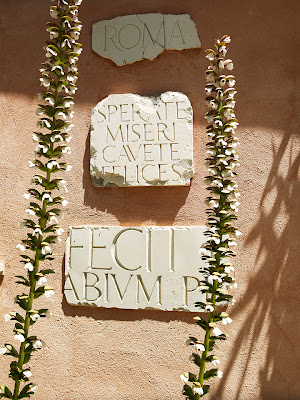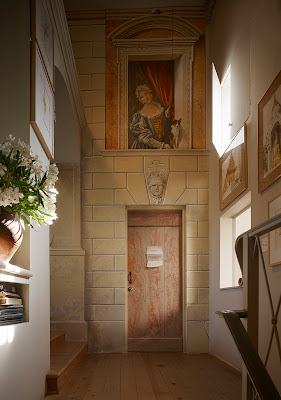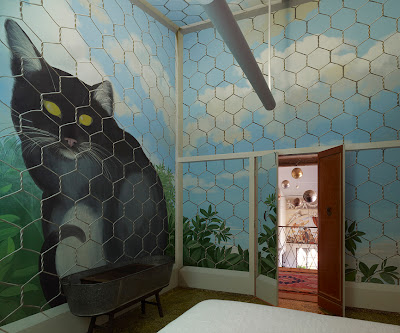Carlo Marchiori’s three-decade project looks as if it had evolved over centuries. Visions of the Veneto, Capri and pop Palladio animate five acres of Calistoga flatlands.
Calistoga, California:
For those who pine to trip the light fantastic around Italy on a Grand Tour, Carlo Marchiori offers the most complete and witty instant classical education.
The glories of Italian culture are portrayed throughout his wooded domain, Ca’Toga, on the banks of the Napa River in the rocky northern reaches of the Napa Valley.
“I started building my villa and the garden statues over thirty years ago, and I just never stopped,” said Marchiori, 61, who was born near Vicenza, Italy, Palladio’s stomping ground.
“My work is theatrical, but always with a wink,” Marchiori said. Rendered in the finest detail, each sculpture and column is then hacked and sanded and chipped to age it thousands of years.
Beyond gateposts topped with jaunty Pulcinello figures stands Marchiori’s handsome Palladian villa, along with a riverside amphitheatre worthy of Caesar, a nymphaeum with sparkling water from the local hot springs, and enough Corinthian columns and noble statues to repopulate the Roman Forum.
In silvery moonlight, with western hills as a backdrop, the rough concrete Doric temple in artist Carlo Marchiori’s garden looks as if it was hewn from Carrara marble. Fluted columns pose heroically on a crumbling foundation. Soaring high above are elaborate friezes and large stone fragments with the traditional entablature. There’s even a broken pediment. All that’s missing is the oracle.
Marchiori’s bravura living room murals were completed over several years. Through chilly winters, the artist painted every delicate flourish standing on a scaffold for hours each day. Every architectural detail—including door pediments—is painted.
Gods of antiquity are depicted en grisaille, a monochromatic technique that gives the appearance of carved Carrara marble.
Roman and Greek gods frolic around a glimmering pool. Stone heads and limbs lie artfully around, like Lord Elgin’s leftovers.
Perhaps most impressively, Marchiori has improvised all of his temples and grand architecture on “four bucks and courage”, using construction-site cast-offs, broken concrete sidewalks hauled from the nearby town of Calistoga, scraps of wood, flea market finds, road-side cast-offs, house paint, and broken tiles and architectural fragments from dismantled buildings.
“Palladio himself improvised,” noted Marchiori. “Often the noblemen who commissioned him wanted a very prestigious villa, but did not have the money. Veneto villa columns were not carved of solid marble, but built of cheap terrace cotta bricks and stone with layers of stucco.”
An ancient-looking stone grotto glows with the nacreous light of hundreds of abalone shells affixed to the walls. Open-mouthed, a dusty Arlecchino head munches weeds beside the villa. A cracked Pompeiian-style urn and stone plaques (OMNIA VINCIT AMOR) seem unearthed from an archaeological dig.
Carlo Marchiori, pictured above, with a new sculpture crafted from a moose horn and clay, has turned a former weed patch into a dreamscape. Using building site debris, terra cotta bricks, and fieldstone, he crafted a sunny piazza and fountains and ‘fragments’ of ancient monuments crafted in sculpted cement. A charming grotto with a domed ceiling was painted to look like a venerable relic from the Roman Empire. For a magical dinner party, Marchiori sets tables with candelabra and bounty from his garden. Flickering light in the grotto transports guests to another time, another place.
“I originally set out to create a country retreat, not an homage to Italy, but naturally I fell back on the historical architecture and the antiquities I grew up with,” he said. “I have a kind of sacred obsession to create. One column leads to another. I envision a temple, a fountain, a mythological beast, and I have an artistic greed to complete it.”
Marchiori’s magical territory was hard-won. He discovered post-purchase that his rocky acreage was full of black clay and laced with boron from the thermal activity that make hot springs and mud baths a popular attraction in Calistoga. Water for his vegetable garden must be filtered.
“I've trucked in tons of soil so that I can grow pomegranates, grape vines, pines, eucalyptus and roses,” said Marchiori. “That’s one reason I throw my energy into columns. They’re low-maintenance.”
Marchiori brings to his work fifty years of art studies, close observation of Italy’s greatest painters, passion, and his experience as a highly regarded decorative artist, in demand for grand projects around the world. He has completed large-scale murals for hotels such as the Bellagio in Las Vegas, and various Trump casinos and hotels. Recent projects also included a fantasy Tuscan landscape for a Pebble Beach elevator interior, grisaille panels for a Los Angeles house, and the elaborate ceiling of a villa in Napa’s Rutherford appellation.
All of his designs are crafted by hand, with help from a handful of workers and his partner, Tony Banthutham.
“I use only a cranky old concrete mixer, so larger pieces are cast in fragments and then fixed into place,” Marchiori said. “I design them in my head, scramble to figure out the correct proportions, and hope the foundations are strong enough. I keep the finishes loose and never add too much falala.”
A pair of ancient-looking pillar gateways to his riverbank garden were crafted from chipped and broken blocks of concrete dumped by a local building crew. Rustic acorn-shaped finials, which could have been lifted from Palladio’s Villa Barbaro in Treviso, were made with shards of roof tiles bought by the truckload from a local roofer.
“To give them a centuries-old look, I cracked them into even smaller chunks,” Marchiori said. “I use anything and everything to create the illusion of antiquity. I’m not a pedantic academic. ”
A twelve-foot high hollow head of Pan, his wild hair and open-mouthed visage pieced together from chunks of richly-hued fieldstone, juts from a wall in a tangle of vines.
“ I hope some birds make their nest inside this sculpture. I would love to see birds fly out of his mouth,” said the artist.
Marchiori said he also paints and stains and daubs the stones and concrete, tiles, metal pipes, and other building materials, to hasten the aging process.
“My goal is to make harmony out of chaos,” said the artist, with steam from the Old Faithful geyser floating in the distance. “ I am the opposite of those who paint their houses every two years and keep everything face-lifted. I don’t believe in ‘forever young’.”
Nature is his accomplice. Rain, sun, wind and valley dust add a convincing patina of centuries.
“After millions of brushtrokes, I have the euphoria of playing an art trick, turning rubble into gold,” he said.
Marchiori grew up in the Veneto town of Bassano del Grappa north east of Venice, and as a boy, roamed the region studying the villas and gardens of the surrounding countryside.
The classic proportions of Palladio’s architecture informed his eye from an early age. He headed to school over the Brenta Bridge, one of Palladio’s landmarks, and, in effect, studied Palladio’s work as he pedaled across on his bicycle.
The classic proportions of Palladio’s architecture informed his eye from an early age. He headed to school over the Brenta Bridge, one of Palladio’s landmarks, and, in effect, studied Palladio’s work as he pedaled across on his bicycle.
Marchiori came to San Francisco in the late Sixties, by way of Japan, New Zealand, and Canada. His Edwardian house in the Haight Ashbury became a tourist stop after he painted a twenty-foot smiling tiger on the facade.
Disinterested with television, film, even computers, he throws his focus on his art. He seldom travels.
Marchiori spends his day painting, sculpting, shaping walls, preparing canvases, glazing his collection of ceramics, and carving plinths. He seems the perfect embodiment of Flaubert’s aphorism, ‘One should be regular and orderly in one’s life, so that one may be violent and original in one’s work.’
Recent projects includes a glamorous grotto with a chandelier of scallop shells that would be a sensation on Capri, and a small outdoor theatre crowned with shard-topped columns. In his Teatro degli Zanni, Marchiori dreams of presenting the Commedia dell’Arte slapstick plays of his childhood.
Marchiori’s list of projects is never-ending. There are molds to carve for a new series of Pompeiian ruins, Bellini-esque murals to complete, and a series of Corinthian column fragments to paint.
In a sense, Marchiori never left Italy. Or at least, Italy never left him.
Summers in Calistoga are hot, so the swimming pool was one of Marchiori’s first grand plans. The artist and two assistants built a pool surround of terra cotta tiles, old bricks, and cracked cement columns. Pine trees, all newly planted, add a suitably Roman flourish.
With its ‘marble’ columns, grassy knolls, and elegant statuary, Marchiori’s swimming pool seems worlds away as nearby Old Faithful Geyser spouts plumes of steam and Mount St. Helena stands as a rocky guardian for acres of vineyards. Thanks to geothermal activity in the region, the artist’s cement flagstones have taken on the patina of centuries.
Marchiori’s restless imagination is evident in these bravura technique samples. Pompeian panels, a painted cabinet with Pulcinello figures, and a painted tribute to Arcimboldo with flowers rather than fruit display his artistry.
Credits:
All photography by California photographer, Adrian Gregorutti, published here with express permission.
To visit Ca’Toga:
Carlo gives private tours of the villa and gardens, by appointment: 707-942-3900.
He can be reached at 707-942-0212 or through his Calistoga gallery at 707-942-3900. www.catoga.com
Photographer Adrian Gregorutti lives in the Napa Valley, and his distinctive and dramatic photography of wineries, residences and antique barns have captured attention of connoisseurs and clients. www.gregophoto.com
Artist statement: "I was born in Argentina of Italian descent. I moved to Europe in my twenties. After meeting an American girl, I moved to the US. Since 1995, I have been living in the Napa Valley with my wife, Sylvia, (the American girl), a linguist teaching Spanish and Italian at a private college here in the valley, and my daughter, Nina, 5. Besides architectural photography, I also photograph for the wine industry. From August 6 through October 31 of this year, the Napa Valley Museum will show some of my architectural work in the exhibition titled "Art & Wine, the Expression of an Industry". I also love languages, traveling, food, and, of course, wine."
To visit Ca’Toga:
Carlo gives private tours of the villa and gardens, by appointment: 707-942-3900.
He can be reached at 707-942-0212 or through his Calistoga gallery at 707-942-3900. www.catoga.com



































15 comments:
Proving yet again that creativity and diligence outweighs all amount of money!
I adore Carlo and his home!! It is such fun to visit and should not be missed an any trip to No.Cal.
FANTASTIC! I've seen a few pics before, but never this many published together. thanks for posting, I really enjoyed!
www.ajbarnesonline.blogspot.com
It is all very attractive. I first learned of the artist and his work when his house was published -- I think in the World of Interiors magazine. That Palladian facade seen in the background was just that, a false front for an industrial metal building!
wonderful post. It's always nice to see Maestro Marchiori and his work featured. he really knows how to live!
Normally I don't like this sort of thing, but these are wonderful. He has a sense for the right texture, and proportion in relation to the landscape, so that they work together, instead of being either too small, or too large. The interiors are inventive too. It would be wonderful to visit his landscape.
One of my favorites books, a visit is on the top of my bucket list. To be able to create what is in your mind---magnifico!
Such a treat to see Adrian Gregorutii's photos! Thanks for the wonderful post.
Dear Friends, near and far!
I love your enthusiasm for Carlo's great genius and wonderful talent. He's a longtime friend of mine--his interiors are in several of my books--and I always love writing about him. He's a raconteur and a wonderful cook, especially in summer when he has tomatoes and basil in the garden.
Of course, several of you are also talented artists! Bravo to you.
Devoted Classicist: You have a fantastic memory! The villa was first published about 25 years ago in the World of Interiors (I also published it)...and it indeed did start life as a metal-sided barn with just the Palladian facade/front exterior! Wow, such a memory.
Be sure to stay in touch--I have some highly original stories coming up, design and style related of course.
cheers, DIANE
I am actually at a loss for words! That has never happened before!
Diane,
Stunning just stunning to have such a blessing of this monumental scale & creativity.
xoxo
Karena
Art by Karena
If I ever run away from home........you will find me there......hiding amongst the "ruins"
this is the masterpiece of the United States.....in my opinion.....and your blog has just shown the best of it!
I have followed this creation for years! Masterful!
Penelope Bianchi.......thank you again, Dianne......for such a magnificent voyage!
Fabulous. I am in awe! Thanks so much for posting so many photographs.
What talent. I agree, he and his work, an American treasure.
marchiori has given us our own bomarzo!
I consider Carlo Marchiori a living treasure. To be able to synthesize the look of antiquity and old Italy and create it out of discards is truly genius.
As I like to do architectural painting and garden design, I can only imagine how wonderful it would be to assist him, and absorb some of his techniques, philosophy, and aesthetic. I hope he has some assistants or apprentices so that these wonderful skills are passed to others...they are desperately needed in North America.
Post a Comment